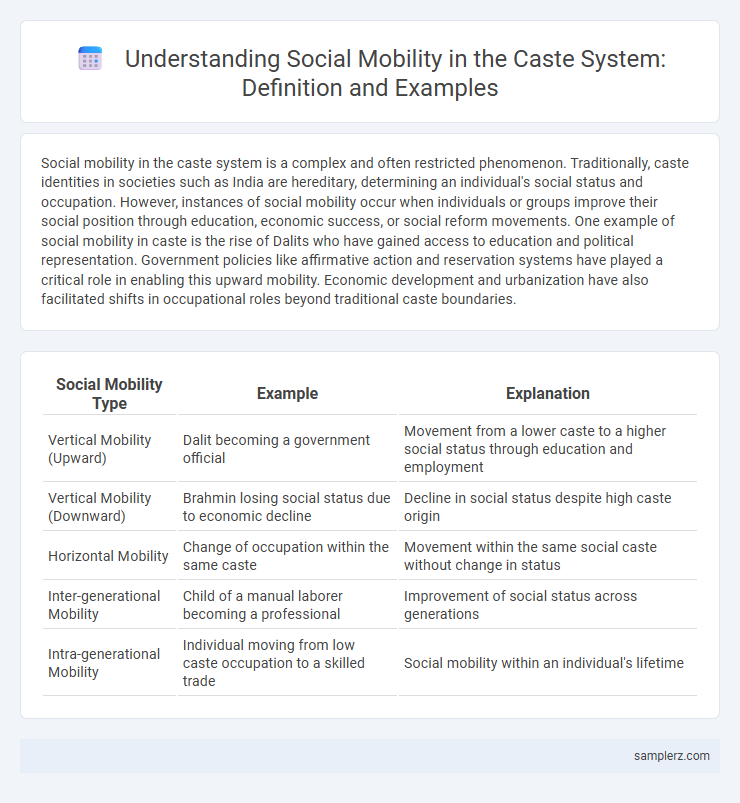Social mobility in the caste system is a complex and often restricted phenomenon. Traditionally, caste identities in societies such as India are hereditary, determining an individual's social status and occupation. However, instances of social mobility occur when individuals or groups improve their social position through education, economic success, or social reform movements. One example of social mobility in caste is the rise of Dalits who have gained access to education and political representation. Government policies like affirmative action and reservation systems have played a critical role in enabling this upward mobility. Economic development and urbanization have also facilitated shifts in occupational roles beyond traditional caste boundaries.
Table of Comparison
| Social Mobility Type | Example | Explanation |
|---|---|---|
| Vertical Mobility (Upward) | Dalit becoming a government official | Movement from a lower caste to a higher social status through education and employment |
| Vertical Mobility (Downward) | Brahmin losing social status due to economic decline | Decline in social status despite high caste origin |
| Horizontal Mobility | Change of occupation within the same caste | Movement within the same social caste without change in status |
| Inter-generational Mobility | Child of a manual laborer becoming a professional | Improvement of social status across generations |
| Intra-generational Mobility | Individual moving from low caste occupation to a skilled trade | Social mobility within an individual's lifetime |
Inter-Caste Marriage: Breaking Traditional Barriers
Inter-caste marriage serves as a powerful example of social mobility by challenging the rigid boundaries of caste hierarchies. Couples from different caste backgrounds defy societal norms, fostering inclusivity and promoting social integration. This shift not only disrupts traditional caste-based discrimination but also paves the way for greater equality and cultural exchange in contemporary society.
Education as a Catalyst for Upward Mobility
Education serves as a powerful catalyst for upward social mobility within caste systems by equipping marginalized groups with skills and qualifications that enhance employment opportunities. Access to quality education enables individuals from lower castes to break traditional barriers, securing positions in professional sectors and thereby improving socioeconomic status. Government scholarship programs and affirmative action policies play a crucial role in facilitating this educational advancement and promoting social equity.
Economic Empowerment Among Marginalized Castes
Economic empowerment among marginalized castes is exemplified by increased access to education and entrepreneurship opportunities that enable upward social mobility. Government reservation policies and targeted skill development programs have facilitated greater representation in professional sectors and business ownership. Enhanced financial inclusion through microfinance and self-help groups supports asset accumulation and economic independence, breaking traditional caste-based barriers.
Political Representation and Social Mobility
Political representation plays a crucial role in enhancing social mobility within caste-based societies by enabling marginalized groups to influence policy decisions and access resources. Reservation policies in legislatures have increased the presence of historically disadvantaged castes, fostering leadership and empowerment at local and national levels. This increased political participation breaks barriers, facilitating upward social movement and reducing caste-based inequalities.
Role of Affirmative Action in Promoting Caste Mobility
Affirmative action policies such as reserved seats in education and government jobs have been pivotal in promoting caste mobility by providing historically marginalized communities with access to opportunities previously denied to them. These measures help reduce social stratification and enable upward economic and social movement within the caste hierarchy. Empirical studies in India demonstrate significant improvements in literacy rates and income levels among Scheduled Castes and Scheduled Tribes owing to affirmative action initiatives.
Urban Migration and Changing Social Identities
Urban migration drives significant shifts in social mobility within caste structures by exposing individuals to diverse social networks and economic opportunities. Migrants often adopt new social identities that challenge traditional caste boundaries, fostering greater acceptance and fluidity in urban settings. This transformation accelerates the erosion of rigid caste hierarchies, enabling upward mobility through education, employment, and cultural adaptation.
Caste Mobility through Professional Achievements
Caste mobility through professional achievements exemplifies how individuals from traditionally marginalized castes access education and high-skilled jobs, breaking historical barriers. Achievements in fields such as technology, medicine, and law facilitate upward social movement, challenging caste-based discrimination. Data from India show increased representation of Scheduled Castes and Scheduled Tribes in government jobs and corporate leadership roles, reflecting a shift towards merit-based advancement and social inclusion.
Influence of Social Reform Movements on Caste Barriers
Social reform movements such as the Bhakti movement and Ambedkarite activism played a crucial role in dismantling caste barriers by promoting social equality and challenging orthodox practices. These movements facilitated upward social mobility by advocating for education, legal rights, and the removal of untouchability, enabling marginalized communities to access better economic and social opportunities. As a result, traditional caste hierarchies weakened, leading to increased interaction and integration among different caste groups.
Media Portrayal of Caste-based Social Mobility
Media portrayal of caste-based social mobility often highlights narratives of marginalized individuals overcoming systemic barriers through education and professional success. Films, television, and digital platforms showcase stories that challenge traditional caste hierarchies, promoting awareness and empathy among wider audiences. These representations contribute to shifting public perceptions and inspire social change by emphasizing meritocratic achievements within historically oppressed communities.
Challenges Faced by First-Generation Achievers in Higher Castes
First-generation achievers in higher castes often confront challenges such as societal expectations to conform to traditional roles and resistance from within their own communities. Limited access to supportive networks and mentorship further hinders their ability to navigate educational and professional spaces. These obstacles can impede upward social mobility despite their academic or career accomplishments.

example of social mobility in caste Infographic
 samplerz.com
samplerz.com